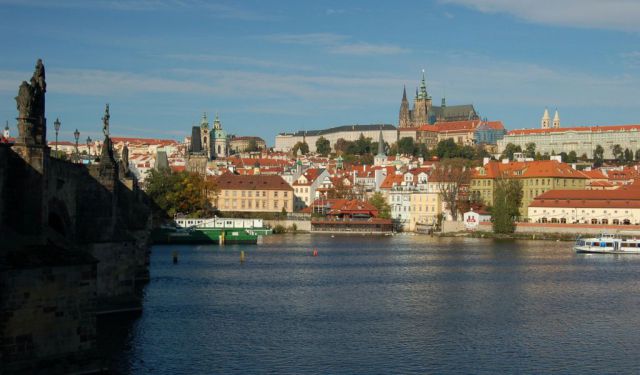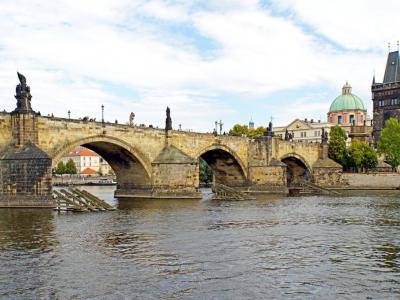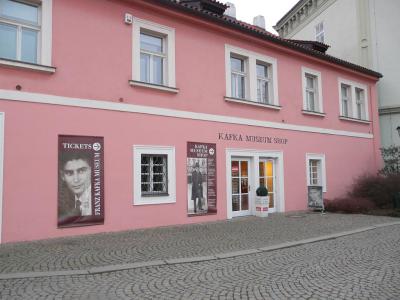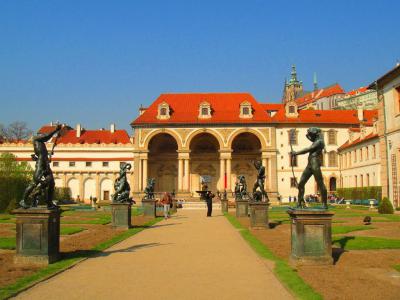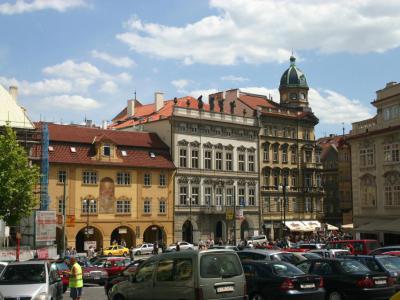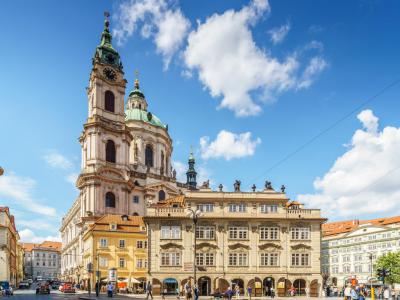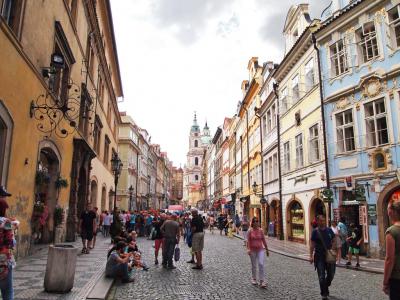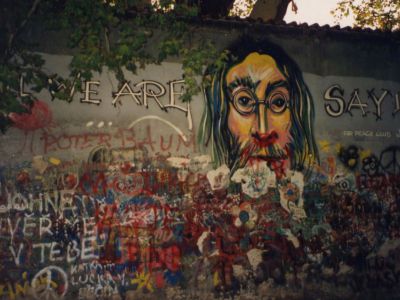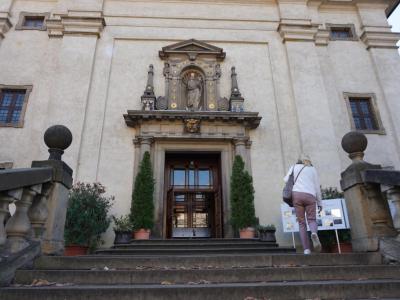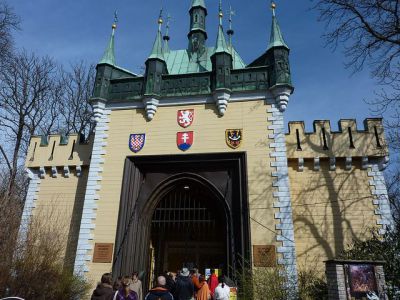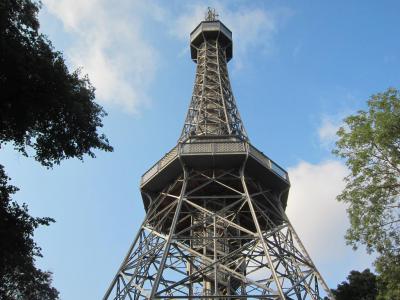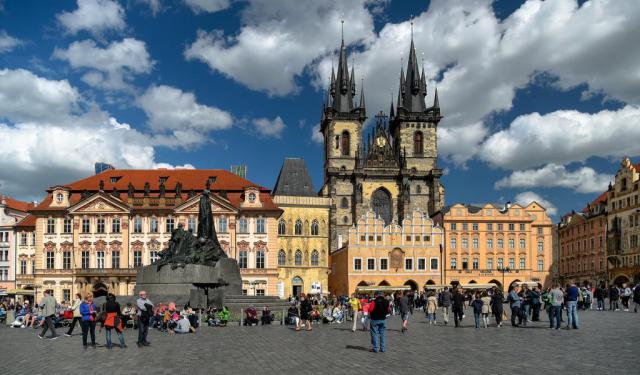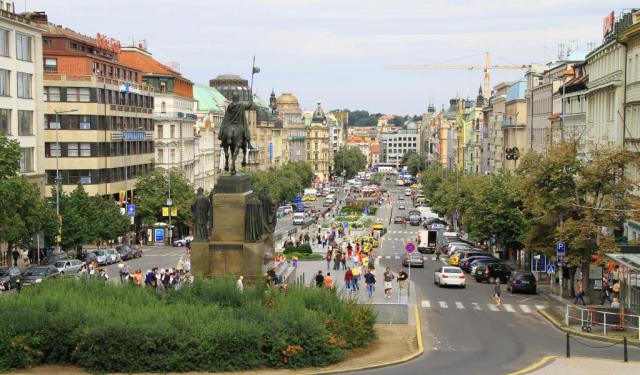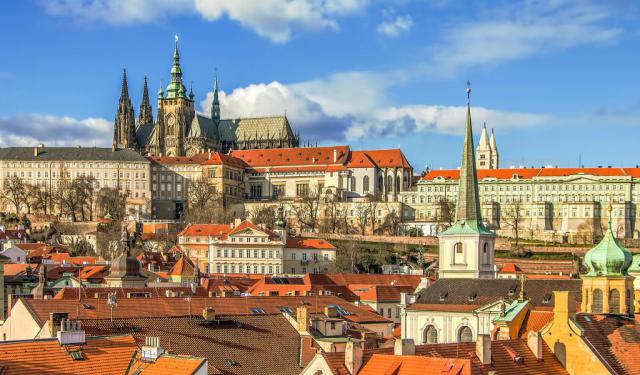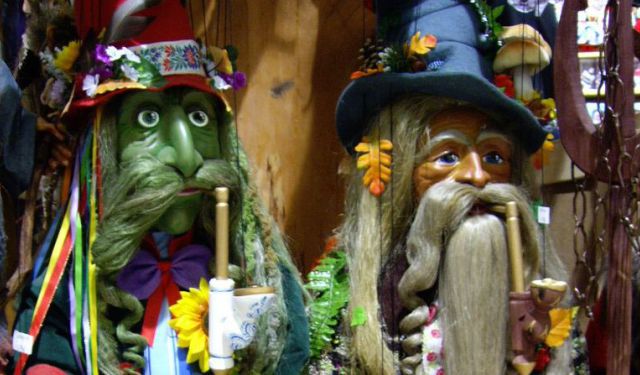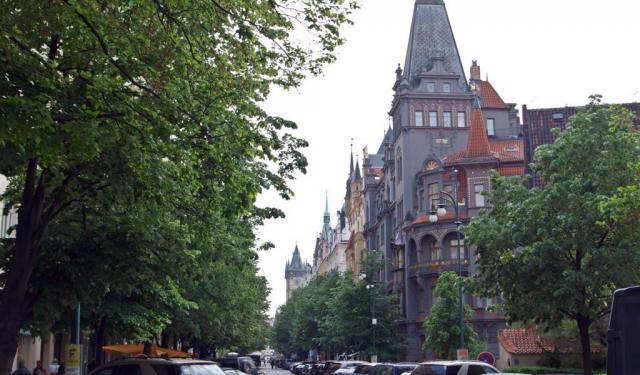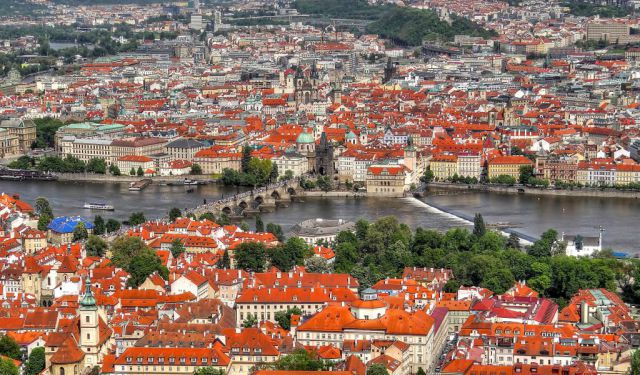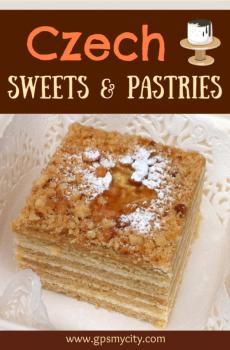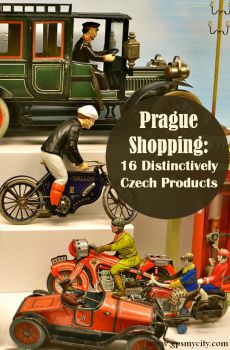Audio Guide: Lesser Town Walking Tour (Self Guided), Prague
Malá Strana, or the “Lesser Town,” lies along the left bank of the Vltava River and remains one of Prague’s most charming and historically layered districts. In medieval times, it was primarily settled by ethnic Germans, and even as Baroque architecture reshaped the neighborhood following the devastating fire of 1541, the area held onto its Germanic roots for generations. Its location near Prague Castle, along with the iconic Charles Bridge linking it to the Old Town, made it a favored address for nobles and foreign envoys-many of whom built the grand, decorative residences that still give the quarter its distinctive character.
At the heart of the district is the Lesser Town Square, a vibrant marketplace since the 10th century. Surrounded by landmarks like the Old Town Hall and the magnificent Church of Saint Nicholas, the square blends history and daily life in a way that feels timeless.
Along the winding alleys, the Franz Kafka Museum invites visitors into the surreal and introspective world of one of Prague’s most enigmatic writers. A short walk away, the grand Wallenstein Palace reveals Prague’s first foray into Baroque design, complete with manicured gardens, richly decorated halls, and a bizarrely enchanting dripstone grotto that seems plucked from a dream.
Follow Bridge Street and you’ll come upon the ever-evolving John Lennon Wall, covered in graffiti, lyrics, and messages of peace-a symbol of freedom and resistance. Just a few streets over, the Church of Our Lady Victorious welcomes pilgrims and visitors alike to see the famed Infant Jesus of Prague, a statue believed by many to possess miraculous powers.
For something a bit more lighthearted, the Mirror Maze near Petřín Hill offers delightful optical illusions and fun for all ages. And for those seeking the best views of the city, the Petřín Lookout Tower-often compared to a miniature Eiffel Tower-delivers breathtaking panoramas from above the treetops.
Unlike Prague’s more modernized parts, the Lesser Town has held on to its original layout and old-world charm. Walking through its streets feels like entering a storybook-one rich in art, history, and quiet elegance. For a relaxed and rewarding experience, try our self-guided walking tour-it’s one of the best ways to uncover the magic of this captivating neighborhood.
At the heart of the district is the Lesser Town Square, a vibrant marketplace since the 10th century. Surrounded by landmarks like the Old Town Hall and the magnificent Church of Saint Nicholas, the square blends history and daily life in a way that feels timeless.
Along the winding alleys, the Franz Kafka Museum invites visitors into the surreal and introspective world of one of Prague’s most enigmatic writers. A short walk away, the grand Wallenstein Palace reveals Prague’s first foray into Baroque design, complete with manicured gardens, richly decorated halls, and a bizarrely enchanting dripstone grotto that seems plucked from a dream.
Follow Bridge Street and you’ll come upon the ever-evolving John Lennon Wall, covered in graffiti, lyrics, and messages of peace-a symbol of freedom and resistance. Just a few streets over, the Church of Our Lady Victorious welcomes pilgrims and visitors alike to see the famed Infant Jesus of Prague, a statue believed by many to possess miraculous powers.
For something a bit more lighthearted, the Mirror Maze near Petřín Hill offers delightful optical illusions and fun for all ages. And for those seeking the best views of the city, the Petřín Lookout Tower-often compared to a miniature Eiffel Tower-delivers breathtaking panoramas from above the treetops.
Unlike Prague’s more modernized parts, the Lesser Town has held on to its original layout and old-world charm. Walking through its streets feels like entering a storybook-one rich in art, history, and quiet elegance. For a relaxed and rewarding experience, try our self-guided walking tour-it’s one of the best ways to uncover the magic of this captivating neighborhood.
How it works: Download the app "GPSmyCity: Walks in 1K+ Cities" from Apple App Store or Google Play Store to your mobile phone or tablet. The app turns your mobile device into a personal tour guide and its built-in GPS navigation functions guide you from one tour stop to next. The app works offline, so no data plan is needed when traveling abroad.
Lesser Town Walking Tour Map
Guide Name: Lesser Town Walking Tour
Guide Location: Czech Republic » Prague (See other walking tours in Prague)
Guide Type: Self-guided Walking Tour (Sightseeing)
# of Attractions: 10
Tour Duration: 2 Hour(s)
Travel Distance: 3.9 Km or 2.4 Miles
Author: vickyc
Sight(s) Featured in This Guide:
Guide Location: Czech Republic » Prague (See other walking tours in Prague)
Guide Type: Self-guided Walking Tour (Sightseeing)
# of Attractions: 10
Tour Duration: 2 Hour(s)
Travel Distance: 3.9 Km or 2.4 Miles
Author: vickyc
Sight(s) Featured in This Guide:
- Charles Bridge
- Franz Kafka Museum
- Wallenstein Palace and Gardens
- Lesser Town Square
- Church of St. Nicholas (Lesser Town)
- Bridge Street (Mostecka)
- John Lennon Wall
- Church of Our Lady Victorious and of the Infant Jesus of Prague
- Mirror Maze
- Petrin Lookout Tower
1) Charles Bridge (must see)
One of Prague’s most iconic landmarks, the Charles Bridge wasn’t just built; it was timed. Construction began on July 9, 1357, at exactly 5:31 in the morning. The oddly precise timing wasn’t random. Holy Roman Emperor Charles IV was a firm believer in numerology and astrology. That moment created a palindrome-135797531-which, in his mind, would grant the bridge strength and longevity. Whether that worked, or whether the secret ingredient was the rumored mix of eggs, wine, or milk stirred into the foundations, we’ll never know. But over six centuries later, the bridge still stands.
Stretching over the Vltava River, it runs 516 meters long and nearly 10 meters wide, supported by 16 sturdy arches with ice guards to fend off the river’s freeze. Until 1841, this was the only way to cross from Prague’s Old Town to the Castle and the Lesser Town. With the boom in traffic in the 20th century, the bridge eventually closed to vehicles and became pedestrian-only in 1978.
Lining both sides are 30 striking Baroque statues, added from the late 1600s through the early 20th century. They complement the Gothic structure underneath and turn any stroll into a kind of open-air museum. As you head toward Lesser Town, keep an eye out for the bronze crucifix-the oldest statue on the bridge-as well as the dramatic tableau of Saint Francis Xavier converting four royal figures from faraway lands: an Indian, Moor, Chinese, and Tartar. Perhaps the most famous is the eighth statue on the right: Saint John of Nepomuk, thrown into the river for refusing to betray the Queen’s confession. Locals say touching his plaque brings luck-or guarantees you’ll return to Prague one day.
Tip: For a quieter, more magical walk, go at dawn or after sunset-when the statues seem to whisper, and the city hushes just long enough to hear them.
Stretching over the Vltava River, it runs 516 meters long and nearly 10 meters wide, supported by 16 sturdy arches with ice guards to fend off the river’s freeze. Until 1841, this was the only way to cross from Prague’s Old Town to the Castle and the Lesser Town. With the boom in traffic in the 20th century, the bridge eventually closed to vehicles and became pedestrian-only in 1978.
Lining both sides are 30 striking Baroque statues, added from the late 1600s through the early 20th century. They complement the Gothic structure underneath and turn any stroll into a kind of open-air museum. As you head toward Lesser Town, keep an eye out for the bronze crucifix-the oldest statue on the bridge-as well as the dramatic tableau of Saint Francis Xavier converting four royal figures from faraway lands: an Indian, Moor, Chinese, and Tartar. Perhaps the most famous is the eighth statue on the right: Saint John of Nepomuk, thrown into the river for refusing to betray the Queen’s confession. Locals say touching his plaque brings luck-or guarantees you’ll return to Prague one day.
Tip: For a quieter, more magical walk, go at dawn or after sunset-when the statues seem to whisper, and the city hushes just long enough to hear them.
2) Franz Kafka Museum
Born in 1883 and gone by 1924, Franz Kafka may not be widely claimed as a Czech writer, given that he wrote in German, but he lived almost his entire life in Prague. Haunted by anxiety, alienation, and a sense of bureaucratic absurdity, he became one of the defining voices of modern literature. So it feels entirely appropriate that the city he wandered through and wrestled with is home to a museum dedicated to his complex legacy.
Rather than playing it safe, the museum fully leans into the strangeness of Kafka’s world. The design is not just a collection of objects behind glass-it’s an immersive dive into his eerie, paradoxical universe. While some find the experience a tad eccentric, the curators clearly aimed for atmosphere over traditional museum norms-and in that sense, they certainly deserve appreciation for their effort.
Prepared to be greeted by a mix of manuscripts, letters, first editions, photographs, and even old newspaper obituaries, all carefully arranged in moody, dimly lit spaces that feel more like psychological theatre than historical archive. Head down to the basement and the surrealism intensifies. One installation features a menacing model of the torture machine from “In the Penal Colony”-a visual that may stick with you long after you leave. Safe to say, it’s not the best choice for a cheerful family outing or a first date, but for fans of Kafka’s unnerving narratives, it’s pure gold.
Upstairs, the experience continues with a blend of audiovisual displays and theatrical effects that capture the themes Kafka lived and wrote-claustrophobia, isolation, and quiet dread. There’s a certain brilliance in the way the museum channels not just the man’s biography, but the emotional texture of his work.
And don’t forget the courtyard outside, where David Černý’s notorious “Pissing Figures” statue steals the spotlight. Two bronze men stand urinating into a pool shaped like the Czech Republic-both irreverent and oddly fitting, given Kafka’s enduring skepticism toward systems and symbols of authority.
Tip: To get the most out of your visit, consider booking a guided tour in advance. Tours are available in several languages, including Czech, English, German, French, and Russian.
Rather than playing it safe, the museum fully leans into the strangeness of Kafka’s world. The design is not just a collection of objects behind glass-it’s an immersive dive into his eerie, paradoxical universe. While some find the experience a tad eccentric, the curators clearly aimed for atmosphere over traditional museum norms-and in that sense, they certainly deserve appreciation for their effort.
Prepared to be greeted by a mix of manuscripts, letters, first editions, photographs, and even old newspaper obituaries, all carefully arranged in moody, dimly lit spaces that feel more like psychological theatre than historical archive. Head down to the basement and the surrealism intensifies. One installation features a menacing model of the torture machine from “In the Penal Colony”-a visual that may stick with you long after you leave. Safe to say, it’s not the best choice for a cheerful family outing or a first date, but for fans of Kafka’s unnerving narratives, it’s pure gold.
Upstairs, the experience continues with a blend of audiovisual displays and theatrical effects that capture the themes Kafka lived and wrote-claustrophobia, isolation, and quiet dread. There’s a certain brilliance in the way the museum channels not just the man’s biography, but the emotional texture of his work.
And don’t forget the courtyard outside, where David Černý’s notorious “Pissing Figures” statue steals the spotlight. Two bronze men stand urinating into a pool shaped like the Czech Republic-both irreverent and oddly fitting, given Kafka’s enduring skepticism toward systems and symbols of authority.
Tip: To get the most out of your visit, consider booking a guided tour in advance. Tours are available in several languages, including Czech, English, German, French, and Russian.
3) Wallenstein Palace and Gardens
Feast your eyes on one of Prague’s grandest Baroque treasures-a 17th-century palace that marked the city’s first step into this dramatic architectural style. With high walls, lavish fountains, and elegant symmetry, the Wallenstein Palace and its gardens offer a full-blown sensory experience. Step into the vaulted Renaissance garden hall that opens out to the greenery, and you’ll instantly feel the aristocratic flair that once defined the place.
As you stroll through the carefully manicured paths, take in the statues and fountains scattered across the grounds-heroic warriors frozen mid-battle, mythological gods locked in eternal drama, and beasts frozen in defeat. And just when you think you’ve seen it all, you come upon the Grotto-a surreal wall of twisting dripstone that looks like it leapt straight from a dream. Faces emerge from the shadows, odd little creatures peek through the formations, and if you look closely, the rock even hints at mysterious doorways and hidden passages. It’s equal parts nature, fantasy, and architectural theater.
The man behind all of this splendor was Albrecht von Wallenstein, a military genius who rose to power during the chaos of the Thirty Years’ War. In 1622, with the Swedes and Protestant armies threatening, Emperor Ferdinand II turned to Wallenstein for help. Newly enriched by marriage and ambitious as ever, Wallenstein offered to raise and fund an army of twenty thousand men-no small favor. In gratitude, the emperor rewarded him with vast estates, including the land where this palace now stands.
He didn’t hesitate to clear the way, demolishing over twenty houses, a brickworks, and several gardens to make room for his vision. And what a vision it was-Wallenstein set out to rival Prague Castle itself. Today, much of the palace is home to the Czech Senate, with rooms like the Knight’s Hall still bearing his larger-than-life presence. There, he’s immortalized in a fresco as Mars, the Roman god of war, charging ahead in a chariot. The old riding school has also found new life as a space for art exhibitions, bridging the palace’s past with its cultural present.
Access to the interiors is limited to weekends, but the gardens welcome visitors every day. Look out for the understated entry points-they’re easy to miss, but what lies beyond is anything but forgettable. And if you’re visiting in summer, don’t miss the open-air concerts and theater performances that bring new life to these historic grounds.
As you stroll through the carefully manicured paths, take in the statues and fountains scattered across the grounds-heroic warriors frozen mid-battle, mythological gods locked in eternal drama, and beasts frozen in defeat. And just when you think you’ve seen it all, you come upon the Grotto-a surreal wall of twisting dripstone that looks like it leapt straight from a dream. Faces emerge from the shadows, odd little creatures peek through the formations, and if you look closely, the rock even hints at mysterious doorways and hidden passages. It’s equal parts nature, fantasy, and architectural theater.
The man behind all of this splendor was Albrecht von Wallenstein, a military genius who rose to power during the chaos of the Thirty Years’ War. In 1622, with the Swedes and Protestant armies threatening, Emperor Ferdinand II turned to Wallenstein for help. Newly enriched by marriage and ambitious as ever, Wallenstein offered to raise and fund an army of twenty thousand men-no small favor. In gratitude, the emperor rewarded him with vast estates, including the land where this palace now stands.
He didn’t hesitate to clear the way, demolishing over twenty houses, a brickworks, and several gardens to make room for his vision. And what a vision it was-Wallenstein set out to rival Prague Castle itself. Today, much of the palace is home to the Czech Senate, with rooms like the Knight’s Hall still bearing his larger-than-life presence. There, he’s immortalized in a fresco as Mars, the Roman god of war, charging ahead in a chariot. The old riding school has also found new life as a space for art exhibitions, bridging the palace’s past with its cultural present.
Access to the interiors is limited to weekends, but the gardens welcome visitors every day. Look out for the understated entry points-they’re easy to miss, but what lies beyond is anything but forgettable. And if you’re visiting in summer, don’t miss the open-air concerts and theater performances that bring new life to these historic grounds.
4) Lesser Town Square
Since the 10th century, this arcaded square has been a center of activity on the left bank of the river-a place where merchants once gathered and locals exchanged more than just goods. These days, the rhythm continues with cafés, restaurants, and shops drawing in visitors, while weekend markets add extra color and energy.
Among the square’s most compelling landmarks is the 14th-century Old Town Hall, once the site where non-Catholic nobles drafted the “Czech Confession” in 1575-a bold call for religious tolerance addressed to the Habsburg emperor, later enshrined into Czech law. Today, that historic building has a new life as a nightclub and bar. But it’s the magnificient 18th-century Saint Nicholas Church that truly steals the show. Built over the remains of a Gothic chapel, its interior dazzles with exquisite statuary and a ceiling fresco that stretches across an astonishing 1,500 square meters.
If you’re sipping coffee at the local Starbucks, you’re actually seated in what used to be the Grömling Palace-a prime example of Prague’s Rococo flair. Across the square at number 18, look for the pistachio-and-vanilla-toned Smiřický Palace, easily recognized by its twin turrets. It was here, in 1618, that Protestant leaders convened before launching what would become the infamous Defenestration of Prague-an act that ignited the Thirty Years' War. Not far from there, the High Baroque Sternberg Palace now houses treasures from the National Gallery.
Commanding a significant portion of the square’s northern side is the Czech Parliament. So don’t be surprised to see suited officials weaving through the crowd-just another reminder that this historic space remains very much alive.
Among the square’s most compelling landmarks is the 14th-century Old Town Hall, once the site where non-Catholic nobles drafted the “Czech Confession” in 1575-a bold call for religious tolerance addressed to the Habsburg emperor, later enshrined into Czech law. Today, that historic building has a new life as a nightclub and bar. But it’s the magnificient 18th-century Saint Nicholas Church that truly steals the show. Built over the remains of a Gothic chapel, its interior dazzles with exquisite statuary and a ceiling fresco that stretches across an astonishing 1,500 square meters.
If you’re sipping coffee at the local Starbucks, you’re actually seated in what used to be the Grömling Palace-a prime example of Prague’s Rococo flair. Across the square at number 18, look for the pistachio-and-vanilla-toned Smiřický Palace, easily recognized by its twin turrets. It was here, in 1618, that Protestant leaders convened before launching what would become the infamous Defenestration of Prague-an act that ignited the Thirty Years' War. Not far from there, the High Baroque Sternberg Palace now houses treasures from the National Gallery.
Commanding a significant portion of the square’s northern side is the Czech Parliament. So don’t be surprised to see suited officials weaving through the crowd-just another reminder that this historic space remains very much alive.
5) Church of St. Nicholas (Lesser Town) (must see)
Towering over Lesser Town is a Baroque masterpiece-one of the most recognizable landmarks along Prague’s left bank. With its colossal green dome and soaring tower, this church was the grandest project of the Jesuits in Bohemia, a bold statement of their significant influence over the region in the 18th century. The contrast between the dome’s solid breadth and the tower’s slender elegance adds a distinctive flair to the city’s silhouette.
Step inside, and you’re met with a riot of pinks and greens that almost overwhelm the senses. The space is alive with movement-from the dynamic statues and vibrant frescoes to the polished, faux-marble columns. At the center, a sweeping ceiling painting brings to life the miracles of Saint Nicholas in true Baroque drama. But it’s the towering dome that steals the spotlight. Look up, and you’ll find four stern-faced Church Fathers circling the space-one of them even clutching a golden thunderbolt as if daring you to question the weight of their message.
The organ alone is worth the visit. Installed in the 1740s and fitted with more than 4,000 pipes, it once echoed with the music of Mozart himself, who played here during his time in Prague. After his death, this is where his Requiem was performed. With such acoustics, it's no wonder the church still hosts classical concerts to this day.
During the communist era, the bell tower wasn’t just a place of worship-it also served as a surveillance outpost for State Security, keeping a close eye on the embassies below. Now, you can climb the 299 steps to the gallery, perched 65 meters above the square, and enjoy a fine perspective over Lesser Town and the Charles Bridge beyond.
Step inside, and you’re met with a riot of pinks and greens that almost overwhelm the senses. The space is alive with movement-from the dynamic statues and vibrant frescoes to the polished, faux-marble columns. At the center, a sweeping ceiling painting brings to life the miracles of Saint Nicholas in true Baroque drama. But it’s the towering dome that steals the spotlight. Look up, and you’ll find four stern-faced Church Fathers circling the space-one of them even clutching a golden thunderbolt as if daring you to question the weight of their message.
The organ alone is worth the visit. Installed in the 1740s and fitted with more than 4,000 pipes, it once echoed with the music of Mozart himself, who played here during his time in Prague. After his death, this is where his Requiem was performed. With such acoustics, it's no wonder the church still hosts classical concerts to this day.
During the communist era, the bell tower wasn’t just a place of worship-it also served as a surveillance outpost for State Security, keeping a close eye on the embassies below. Now, you can climb the 299 steps to the gallery, perched 65 meters above the square, and enjoy a fine perspective over Lesser Town and the Charles Bridge beyond.
6) Bridge Street (Mostecka)
Passing through the arch beneath the Lesser Town Bridge Towers, you’ll find yourself on Bridge Street-a narrow cobblestone lane that has connected Charles Bridge to the Lesser Town Square for over 750 years. Framed by a mix of Renaissance, Baroque, and Rococo facades dating between the 14th and 18th centuries, the street feels like a vivid time capsule. Some of the buildings still carry their original decorative touches: a chained bear at No. 4, a striking bronze door at No. 17, three goats at No. 18, and even a bust of cellist Zelenka. With all its character and charm, it’s no surprise this was once part of the royal coronation route.
Just beyond the towers, on the right side of the street, look for a house marked by three painted ostriches. Once home to Jan Fux, a feather merchant with a flair for fashion, the Renaissance-style building served as both residence and storefront. In 1606, Fux commissioned the bold ostrich design to advertise his trade in luxurious plumes-ostrich feathers were all the rage for hats, uniforms, horse trappings, fans, and finery of every sort.
As you continue your stroll, pause to admire the Gothic tower hidden in the courtyard of “At the Three Golden Bells,” the intricate ironwork and sculptural details on the “At the Black Eagle” house, and the candy-colored, pink-and-yellow Rococo facade of the Kounic Palace.
Toward street’s lower end, you’ll find a mix of boutique shops, inviting restaurants and bars catering to the stream of passersby. When it’s time for a break, stop in at ROESEL café-a warm, family-run spot inside a historic building. Enjoy their daily specials, try a slice of homemade cake with craft beer, and take a moment to explore the mini-exhibition and the charming courtyard.
Just beyond the towers, on the right side of the street, look for a house marked by three painted ostriches. Once home to Jan Fux, a feather merchant with a flair for fashion, the Renaissance-style building served as both residence and storefront. In 1606, Fux commissioned the bold ostrich design to advertise his trade in luxurious plumes-ostrich feathers were all the rage for hats, uniforms, horse trappings, fans, and finery of every sort.
As you continue your stroll, pause to admire the Gothic tower hidden in the courtyard of “At the Three Golden Bells,” the intricate ironwork and sculptural details on the “At the Black Eagle” house, and the candy-colored, pink-and-yellow Rococo facade of the Kounic Palace.
Toward street’s lower end, you’ll find a mix of boutique shops, inviting restaurants and bars catering to the stream of passersby. When it’s time for a break, stop in at ROESEL café-a warm, family-run spot inside a historic building. Enjoy their daily specials, try a slice of homemade cake with craft beer, and take a moment to explore the mini-exhibition and the charming courtyard.
7) John Lennon Wall
Though John Lennon never stepped foot in Czechoslovakia, his voice, his message of peace, and his belief in the power of imagination managed to reach across borders-and through concrete. After his tragic death in 1980, an anonymous artist painted his portrait on a wall near the French Embassy in Prague, along with lyrics from Beatles songs. It was a bold act of defiance, carried out under a regime that viewed any expression of Western ideals as dangerous subversion.
What began as a quiet tribute quickly became something much more. The wall turned into a living symbol of resistance, where young people scrawled lyrics, poems, and messages of hope-despite knowing that authorities would rush to whitewash them, again and again. But each time the wall was scrubbed clean, it came back to life overnight, as if the voices of the people simply refused to be silenced.
By 1988, the wall had become a flashpoint. Czech students gathered there to protest the regime, leading to direct confrontations with the security forces. The government tried to dismiss the movement by mocking it, calling the protestors “Lennonists”, accusing them of drunken rebellion and labeling them tools of Western propaganda. But the label backfired. Lennonism stuck around as a symbol of peaceful resistance and youthful courage.
In 2014, the wall took another turn when a group of local art students painted it entirely white, declaring “The Wall is Over.” Rather than ending its story, they invited a new generation to add their own voices. The blank slate was quickly filled again, and in 2019, on the 30th anniversary of the Velvet Revolution, iconic Beatles imagery was restored.
While spray painting is no longer allowed due to preservation efforts, visitors are still welcome to leave their mark using chalk, markers, or pencil. One way or another, the wall continues to speak-and to listen.
What began as a quiet tribute quickly became something much more. The wall turned into a living symbol of resistance, where young people scrawled lyrics, poems, and messages of hope-despite knowing that authorities would rush to whitewash them, again and again. But each time the wall was scrubbed clean, it came back to life overnight, as if the voices of the people simply refused to be silenced.
By 1988, the wall had become a flashpoint. Czech students gathered there to protest the regime, leading to direct confrontations with the security forces. The government tried to dismiss the movement by mocking it, calling the protestors “Lennonists”, accusing them of drunken rebellion and labeling them tools of Western propaganda. But the label backfired. Lennonism stuck around as a symbol of peaceful resistance and youthful courage.
In 2014, the wall took another turn when a group of local art students painted it entirely white, declaring “The Wall is Over.” Rather than ending its story, they invited a new generation to add their own voices. The blank slate was quickly filled again, and in 2019, on the 30th anniversary of the Velvet Revolution, iconic Beatles imagery was restored.
While spray painting is no longer allowed due to preservation efforts, visitors are still welcome to leave their mark using chalk, markers, or pencil. One way or another, the wall continues to speak-and to listen.
8) Church of Our Lady Victorious and of the Infant Jesus of Prague
In one of Prague’s more unexpected turn of events, the modest-looking Church of Our Lady Victorious has become home to one of the most famous and flamboyant religious figures in Europe: the Infant Jesus of Prague. Housed in a glass case near the altar, this wax figure of a toddler-sized Christ, frozen in regal pose, is known as the “Infant Jesus of Prague”. He may look like a pint-sized monarch, but for many, he’s a vessel of miraculous power.
Though the statue may strike some as over-the-top or even kitschy, its impact is undeniable. Pilgrims travel here from around the world, especially from southern Europe and Poland, to pray before the Infant Jesus. And his fame didn’t start here. The statue arrived from Spain in the 16th century, already celebrated for its divine aura, and has remained a cherished icon ever since.
Now, what truly sets this holy child apart is his fashion game. With a wardrobe of nearly one hundred ornate outfits, the Infant Jesus could give any royal closet a run for its money. These miniature garments are cared for and changed by Carmelite nuns, who treat each ensemble with the reverence of a sacred ritual. Should you wish to peek behind the seams, a tiny museum above the south aisle staircase showcases a selection of his finest looks, many donated by admirers from across the globe.
For visitors seeking a piece of the divine to call their own, there’s also a souvenir shop cleverly hidden behind the main altar. There, you can pick up everything from miniature replicas to rosaries, postcards, and candles-plenty of ways to commemorate your visit, spiritual or otherwise.
And here’s the miraculous bonus-entry to the church is absolutely free.
Though the statue may strike some as over-the-top or even kitschy, its impact is undeniable. Pilgrims travel here from around the world, especially from southern Europe and Poland, to pray before the Infant Jesus. And his fame didn’t start here. The statue arrived from Spain in the 16th century, already celebrated for its divine aura, and has remained a cherished icon ever since.
Now, what truly sets this holy child apart is his fashion game. With a wardrobe of nearly one hundred ornate outfits, the Infant Jesus could give any royal closet a run for its money. These miniature garments are cared for and changed by Carmelite nuns, who treat each ensemble with the reverence of a sacred ritual. Should you wish to peek behind the seams, a tiny museum above the south aisle staircase showcases a selection of his finest looks, many donated by admirers from across the globe.
For visitors seeking a piece of the divine to call their own, there’s also a souvenir shop cleverly hidden behind the main altar. There, you can pick up everything from miniature replicas to rosaries, postcards, and candles-plenty of ways to commemorate your visit, spiritual or otherwise.
And here’s the miraculous bonus-entry to the church is absolutely free.
9) Mirror Maze
As you make your way up the slopes of Petřín Hill, one little structure is bound to catch your eye-a fairy-tale-like building in neo-Gothic style, complete with turrets and even a mock drawbridge. It might look like a toy castle, but it’s actually a charming replica of a gate from the ancient Vyšehrad fortress. Step inside, and you’ll find one of Prague’s most whimsical attractions.
Originally built for the Jubilee Exhibition in 1891, the Mirror Maze has since become a beloved spot for families, school groups, and anyone in the mood for a good laugh. Open daily from April to October, it offers affordable fun in a setting that feels like a cross between a carnival and a storybook.
The adventure begins with a maze of 31 mirrors designed to trick your sense of direction-and your sense of self. Reflections bounce from wall to wall, turning a simple walk into a playful challenge. Beyond the maze, you’re also treated to a large-scale diorama depicting the historic Battle of Charles Bridge in 1648, when local students and townspeople famously defended Prague from invading Swedish forces. Spanning 80 square meters, this dramatic scene was painted in just 50 days by brothers Adolf and Karel Liebscher. The level of detail makes it feel more like a stage set than a static image.
And then there’s the grand finale-the Laughter Hall. Here, 14 curved mirrors bend and stretch your reflection into all sorts of comical proportions. Tall becomes tiny, wide turns narrow, and everyone leaves with a smile.
Originally built for the Jubilee Exhibition in 1891, the Mirror Maze has since become a beloved spot for families, school groups, and anyone in the mood for a good laugh. Open daily from April to October, it offers affordable fun in a setting that feels like a cross between a carnival and a storybook.
The adventure begins with a maze of 31 mirrors designed to trick your sense of direction-and your sense of self. Reflections bounce from wall to wall, turning a simple walk into a playful challenge. Beyond the maze, you’re also treated to a large-scale diorama depicting the historic Battle of Charles Bridge in 1648, when local students and townspeople famously defended Prague from invading Swedish forces. Spanning 80 square meters, this dramatic scene was painted in just 50 days by brothers Adolf and Karel Liebscher. The level of detail makes it feel more like a stage set than a static image.
And then there’s the grand finale-the Laughter Hall. Here, 14 curved mirrors bend and stretch your reflection into all sorts of comical proportions. Tall becomes tiny, wide turns narrow, and everyone leaves with a smile.
10) Petrin Lookout Tower (must see)
After the Eiffel Tower dazzled the world at the 1889 Paris Exposition, Prague felt the urge to add a similar landmark of its own. Just two years later, in 1891, the Petřín Lookout Tower rose into view-built in an impressive four months as part of the General Land Centennial Exhibition.
Though only 60 meters tall, its position atop Petřín Hill gives it a commanding presence, offering views that rival those from much taller structures. And while it clearly takes inspiration from its Parisian cousin, this Czech version has a personality of its own-most notably, an octagonal base rather than a square one.
When first unveiled, the tower featured a small elevator powered by gas, later upgraded to electric. In 1953, it gained new importance as a broadcasting tower, when engineers installed a television antenna to serve the growing needs of postwar Czechoslovakia. Then, a major renovation completed in 2002 brought modern upgrades, including a new lift to improve access for elderly visitors and those with limited mobility.
For everyone else, the real thrill lies in the climb-299 steps winding upward in a gentle spiral. Separate staircases for going up and coming down keep the flow smooth, and the reward at the top is well worth the effort: sweeping panoramic views of Prague, with its red rooftops, church spires, and winding Vltava River.
A visit to the tower also pairs beautifully with a stroll through Petřín Hill. If you're up for a scenic walk, you can make your way on foot, either climbing from the base or descending from the top. However you arrive, you’ll be rewarded with one of the most spectacular vantage points in the city.
Tip: The easiest way to reach the top is by taking the funicular from the Petřín station near the Újezd tram stop. Just make sure to validate your public transport ticket before boarding.
Though only 60 meters tall, its position atop Petřín Hill gives it a commanding presence, offering views that rival those from much taller structures. And while it clearly takes inspiration from its Parisian cousin, this Czech version has a personality of its own-most notably, an octagonal base rather than a square one.
When first unveiled, the tower featured a small elevator powered by gas, later upgraded to electric. In 1953, it gained new importance as a broadcasting tower, when engineers installed a television antenna to serve the growing needs of postwar Czechoslovakia. Then, a major renovation completed in 2002 brought modern upgrades, including a new lift to improve access for elderly visitors and those with limited mobility.
For everyone else, the real thrill lies in the climb-299 steps winding upward in a gentle spiral. Separate staircases for going up and coming down keep the flow smooth, and the reward at the top is well worth the effort: sweeping panoramic views of Prague, with its red rooftops, church spires, and winding Vltava River.
A visit to the tower also pairs beautifully with a stroll through Petřín Hill. If you're up for a scenic walk, you can make your way on foot, either climbing from the base or descending from the top. However you arrive, you’ll be rewarded with one of the most spectacular vantage points in the city.
Tip: The easiest way to reach the top is by taking the funicular from the Petřín station near the Újezd tram stop. Just make sure to validate your public transport ticket before boarding.
Walking Tours in Prague, Czech Republic
Create Your Own Walk in Prague
Creating your own self-guided walk in Prague is easy and fun. Choose the city attractions that you want to see and a walk route map will be created just for you. You can even set your hotel as the start point of the walk.
Old Town Walking Tour
Prague’s Old Town is a living tapestry of medieval roots and vibrant modern life, wrapped in narrow cobblestone streets and brimming with architectural treasures. Once a self-contained settlement, it was protected by a semi-circular moat and a fortified wall, both tracing the curve of the Vltava River. Although the moat is long gone, its path survives in the form of key streets-most notably Na... view more
Tour Duration: 2 Hour(s)
Travel Distance: 2.8 Km or 1.7 Miles
Tour Duration: 2 Hour(s)
Travel Distance: 2.8 Km or 1.7 Miles
New Town Walking Tour
The youngest (founded in 1348) and the largest (three times the size of the Old Town), the New Town (or Nove Mesto) of Prague is one of the five originally independent townships that today form the historic center of the Czech capital. This vibrant district offers a mix of historical charm and modern amenities and is traditionally dense with tourists.
At its heart lies Wenceslas Square, a... view more
Tour Duration: 2 Hour(s)
Travel Distance: 3.1 Km or 1.9 Miles
At its heart lies Wenceslas Square, a... view more
Tour Duration: 2 Hour(s)
Travel Distance: 3.1 Km or 1.9 Miles
Hradcany (Castle District) Walking Tour
Prague’s Castle District is a neighborhood where history feels almost tangible-an atmospheric blend of towering landmarks, quiet courtyards, and sweeping city views. At its heart sits the mighty Prague Castle, often cited as the largest castle complex in the world. Its origins stretch back to the 9th century, and over time, it has been home to Bohemian kings, Holy Roman emperors, Communist... view more
Tour Duration: 2 Hour(s)
Travel Distance: 3.0 Km or 1.9 Miles
Tour Duration: 2 Hour(s)
Travel Distance: 3.0 Km or 1.9 Miles
Old Town Souvenir Shopping
Strolling through the Old Town of Prague, souvenir shopping becomes a delightful adventure. Indeed, it would be a pity to leave Prague without having explored its specialty shops and bringing home something truly original and unique to the city.
One of the prime spots for such endeavors is the Municipal House, a majestic Art Nouveau building that houses various shops and boutiques. Here,... view more
Tour Duration: 1 Hour(s)
Travel Distance: 1.7 Km or 1.1 Miles
One of the prime spots for such endeavors is the Municipal House, a majestic Art Nouveau building that houses various shops and boutiques. Here,... view more
Tour Duration: 1 Hour(s)
Travel Distance: 1.7 Km or 1.1 Miles
Jewish Quarter Walking Tour
The Jewish Quarter of Prague carries over a thousand years of memory etched into its streets, synagogues, and gravestones. Jewish communities began settling in this area as early as the 10th century, and although they were later forced into a walled ghetto, they cultivated a vibrant cultural and intellectual life-especially during the 16th century, a golden age shaped by the influence of Rabbi Ben... view more
Tour Duration: 1 Hour(s)
Travel Distance: 1.1 Km or 0.7 Miles
Tour Duration: 1 Hour(s)
Travel Distance: 1.1 Km or 0.7 Miles
Prague Introduction Walking Tour
Nicknamed the “City of a Hundred Spires,” Prague is a living gallery of history and architecture, home to world-class museums, eclectic galleries, numerous theaters, and a seemingly endless collection of historic landmarks.
The name Praha comes from the old Slavic word “práh”, which means “rapid”, nodding to the city's beginnings at a crossing on the Vltava River. Legend... view more
Tour Duration: 2 Hour(s)
Travel Distance: 3.2 Km or 2 Miles
The name Praha comes from the old Slavic word “práh”, which means “rapid”, nodding to the city's beginnings at a crossing on the Vltava River. Legend... view more
Tour Duration: 2 Hour(s)
Travel Distance: 3.2 Km or 2 Miles
Useful Travel Guides for Planning Your Trip
Czech Sweets and Pastries
Once part of the Austro-Hungarian Empire, the Czechs have duly absorbed the dessert-making know-how of their Austrian neighbors to complement their own confectionery heritage deeply rooted in the Eastern European, Slavic tradition. The end result of such cultural blend is the abundance of pastries,...
Prague Shopping: 15 Distinctively Czech Products to Bring Home
Previously known mainly for its beer and ice-hockey (both for a very good reason), today's Czech Republic - and, primarily, its capital city Prague - is seen among the top European tourist destinations emerged following the breakup of the Soviet Bloc. A shooting ground for some Hollywood...
The Most Popular Cities
/ view all
